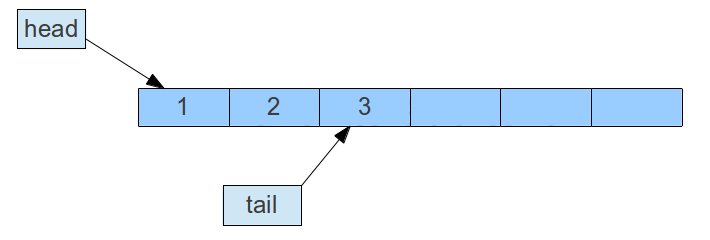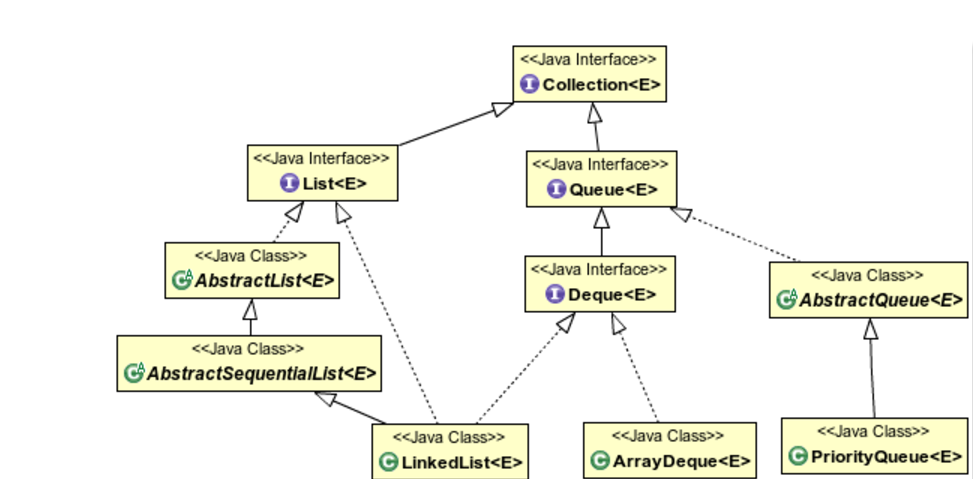定义
队列是一种特殊的线性表,它只允许在表的前端进行删除操作,而在表的后端进行插入操作。
LinkedList类实现了Queue接口,因此我们可以把LinkedList当成Queue来用
图例
Queue本身是一种先入先出的模型(FIFO),和我们日常生活中的排队模型很类似。根据不同的实现,他们主要有数组和链表两种实现形式。如下图:


与队列相关的类的关系图如下:

常用方法
| 序号 | 方法名 | 描述 |
| 1 | boolean add(E e) | 将指定的元素插入到队列中。 |
| 2 | Object element() | 检索该队列的头。 |
| boolean offer(E e) | 将指定元素插入到该队列中(在该队列容量之内)。 | |
| 3 | Object peek() | 检索该队列的头,如果该队列为空返回null。 |
| 4 | Object poll() | 检索并删除该队列的头,如果该队列为空返回null。 |
| 5 | Object remove() | 检索并删除该队列的头。 |
源码
1 package java.util; 2 3 public interface Queue<E> extends Collection<E> { 4 /** 5 * Inserts the specified element into this queue if it is possible to do so 6 * immediately without violating capacity restrictions, returning 7 * {@code true} upon success and throwing an {@code IllegalStateException} 8 * if no space is currently available. 9 * 10 * @param e the element to add 11 * @return {@code true} (as specified by {@link Collection#add}) 12 * @throws IllegalStateException if the element cannot be added at this 13 * time due to capacity restrictions 14 * @throws ClassCastException if the class of the specified element 15 * prevents it from being added to this queue 16 * @throws NullPointerException if the specified element is null and 17 * this queue does not permit null elements 18 * @throws IllegalArgumentException if some property of this element 19 * prevents it from being added to this queue 20 */ 21 boolean add(E e); 22 23 /** 24 * Inserts the specified element into this queue if it is possible to do 25 * so immediately without violating capacity restrictions. 26 * When using a capacity-restricted queue, this method is generally 27 * preferable to {@link #add}, which can fail to insert an element only 28 * by throwing an exception. 29 * 30 * @param e the element to add 31 * @return {@code true} if the element was added to this queue, else 32 * {@code false} 33 * @throws ClassCastException if the class of the specified element 34 * prevents it from being added to this queue 35 * @throws NullPointerException if the specified element is null and 36 * this queue does not permit null elements 37 * @throws IllegalArgumentException if some property of this element 38 * prevents it from being added to this queue 39 */ 40 boolean offer(E e); 41 42 /** 43 * Retrieves and removes the head of this queue. This method differs 44 * from {@link #poll poll} only in that it throws an exception if this 45 * queue is empty. 46 * 47 * @return the head of this queue 48 * @throws NoSuchElementException if this queue is empty 49 */ 50 E remove(); 51 52 /** 53 * Retrieves and removes the head of this queue, 54 * or returns {@code null} if this queue is empty. 55 * 56 * @return the head of this queue, or {@code null} if this queue is empty 57 */ 58 E poll(); 59 60 /** 61 * Retrieves, but does not remove, the head of this queue. This method 62 * differs from {@link #peek peek} only in that it throws an exception 63 * if this queue is empty. 64 * 65 * @return the head of this queue 66 * @throws NoSuchElementException if this queue is empty 67 */ 68 E element(); 69 70 /** 71 * Retrieves, but does not remove, the head of this queue, 72 * or returns {@code null} if this queue is empty. 73 * 74 * @return the head of this queue, or {@code null} if this queue is empty 75 */ 76 E peek(); 77 }
参考:http://blog.csdn.net/u010617952/article/details/51726789